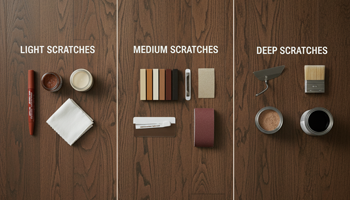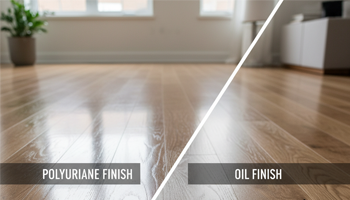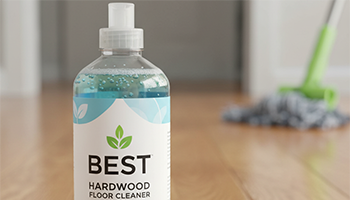Complete Guide by Wood Species & Finish
If you want hardwood floor care by species that actually works long-term, start with this rule I drill into every client: match your cleaner to your finish—not your wood species. After hundreds of residential and commercial jobs, I’ve seen beautiful floors ruined in months by “all-purpose” products that don’t play well with polyurethane, oil, wax, or lacquer. In one 1920s walnut restoration (~$50,000 scope), a popular oil soap left a stubborn film on a polyurethane topcoat—proof that the wrong chemistry is expensive. This master guide shows you exactly how to identify your wood and finish, then maintain each combo with species-specific tips, high-traffic strategies, and pet-safe routines.
Understanding Your Hardwood Floor: Species and Finish Identification
How to Identify Your Wood Species (Oak, Maple, Walnut, Bamboo)
- Oak (red vs. white): prominent grain and open pores; red oak shows pinkish undertones, white oak leans beige/olive with tighter rays.
- Maple: tight, subtle grain; often uniform and light; birdseye or curly figure on premium boards.
- Walnut: rich chocolate brown with creamy sapwood; grain is straight to wavy; naturally darker overall.
- Bamboo: looks linear/knuckled; “horizontal/vertical” planks show nodes; strand-woven looks more mottled and very dense.
- Quick tests: unfinished edges inside vents/closets reveal true color and pore structure; a bright flashlight helps read grain.
Pro tip from the field: species alone doesn’t dictate cleaning chemistry—the finish does.
Recognizing Different Finish Types (Polyurethane, Oil, Wax, Lacquer)
- Polyurethane (water- or oil-based): forms a plasticized film on top; usually glossy to satin; resists water spots; no oily feel.
- Penetrating oil / hardwax oil: feels matte/natural; water darkens the spot briefly; can be spot-repaired with maintenance oil.
- Wax: low sheen, silky hand; buffing marks are common; water can turn white (blushing).
- Lacquer: very smooth, fast-dry look; sensitive to strong solvents.
- At-home check (hidden area): a tiny acetone spot test can soften lacquer and dull wax, but not polyurethane; oil finishes absorb and darken. Use ventilation and minimal solvent on a cotton swab.
Daily Maintenance Essentials for All Hardwood Floors
The Right Tools: Microfiber Mops, Soft-Bristle Brooms, and Vacuums
- Dry dust daily with a flat microfiber mop; it captures grit that causes micro-scratches.
- Vacuum weekly with a soft bare-floor head (no beater bar).
- Keep felt pads on every furniture foot; replace quarterly.
Establishing a Daily Cleaning Routine
- Dry dust high-traffic lanes.
- Spot-clean sticky spills immediately (pH-neutral cleaner recommended by the finish manufacturer).
- Damp-mop 1–2× per week with a well-wrung microfiber pad.
- Never flood the floor; no steam mops.
In my own service protocols, switching clients from cotton string mops to flat microfiber cut cleaning time by ~30% and reduced swirl marks.
Species-Specific Care: Oak Hardwood Flooring
Red Oak vs. White Oak: Durability and Maintenance Differences
- Janka: red oak ~1290; white oak ~1360.
- Care angle: white oak’s tighter grain hides dents a bit better; red oak’s open grain accepts stain more readily.
Cleaning Solutions Safe for Oak Floors
- Use pH-neutral, residue-free cleaners formulated for your finish (poly or oil). Avoid oil soaps on polyurethane.
Dealing with Oak’s Prominent Grain Patterns
- Grain camouflages light scratches. Use satin sheens to keep lanes even; refresh with a screen & recoat rather than deep sand when wear is uniform.
Maple Hardwood Floor Care and Maintenance
Protecting Maple’s Light Color from Discoloration
- UV can amber maple; use UV-blocking window film and rotate rugs quarterly.
Managing Maple’s Sensitivity to Visible Scratches
- Maple is harder (~1450 Janka) yet shows scratches more. Keep grit off and prefer matte/satin to mask micro-lines.
Pet-Friendly Care for Maple Floors
- Keep nails rounded and use runner rugs over chase paths. Choose pet-safe hardwood floor cleaner (see Pet-Safe section) to avoid residues that highlight streaks.
Walnut Floor Maintenance: Preserving Natural Beauty
Understanding Walnut’s Photosensitivity
- American black walnut (~1010 Janka) lightens with UV. Expect color shift; move rugs monthly for even aging.
Traffic Pattern Considerations for Softer Woods
- Install larger area rugs in entries and under chairs. Consider annual maintenance coats in busy households.
Color Maintenance and Fading Prevention
- Prefer tinted maintenance oil on oil-finished walnut to keep depth; for poly, use UV-inhibiting finishes at next recoat.
On that 1920s walnut project, the biggest save was controlling chemistry—once we stripped the residue and matched the finish, clarity returned.
Bamboo Flooring Care: Unique Requirements
Moisture Control for Bamboo
- Bamboo is grass; some constructions (especially non-strand) are moisture-sensitive. Maintain 35–55% RH and clean only with lightly damp microfiber.
Scratch Prevention Strategies
- Strand-woven is very dense; still use felt pads, shoe-free policy, and mats at every exterior door.
Eco-Friendly Cleaning Solutions
- Use biodegradable, pH-neutral cleaners made for bamboo/wood finishes—strong alkalis/acids can etch.
Polyurethane Finish Maintenance
Water-Based vs Oil-Based Polyurethane Care
- Water-based poly: stays clearer; recoat cycles 3–5 years in active homes.
- Oil-based poly: ambers warm; typically 5–7 years before screen & recoat, depending on traffic.
Screen and Recoat Timeline
- If you see micro-scratches and dull lanes but no bare wood, a screen & recoat restores sheen without full sanding.
Products to Avoid on Polyurethane Surfaces
- No oil soaps, paste wax, vinegar, ammonia, citrus solvents, steam, or abrasive pads. These cause haze, etch, or adhesion issues.
Oil-Finished Hardwood Floor Care
Regular Re-Oiling Schedule
- Residential average: 12–18 months for maintenance oil; high-traffic or commercial: 6–12 months.
Special Cleaning Requirements
- Use soap for oil-finished floors (non-build-up). Spot-repair with maintenance oil on traffic lanes.
Natural Oil vs Hardwax Oil Maintenance
- Natural oil: frequent light re-oiling; highest “wood feel.”
- Hardwax oil: slightly tougher film; accepts maintenance oil/wax for quick revivals.
I prefer hardwax oil in busy homes—faster spot fixes keep floors camera-ready without full crews.
Managing High-Traffic Patterns and Wear Areas
Entry Point Protection Strategies
- Exterior scraper mats + interior absorbent mats reduce grit by >70%. Enforce a no-shoes rule.
Strategic Rug Placement
- Place runners on hallways and “dog race tracks.” Choose breathable rug pads labeled safe for wood finishes.
Furniture Protection Methods
- Felt pads (dense, non-dyed) under all legs; for heavy pieces, add wide glides and avoid rolling casters.
Pet-Safe Products and Techniques
Non-Toxic Floor Cleaners Safe for Pets
Look for third-party marks like EPA Safer Choice and products labeled for hardwood and your finish type. Always spot test.
Reference authorities:
<a href=»https://www.epa.gov/saferchoice» rel=»nofollow»>EPA Safer Choice</a>
Dealing with Pet Scratches and Accidents
- Wipe accidents ASAP; enzymes for odor (keep off finish seams).
- Micro-scratch build-up on poly? Consider a satin recoat to reset sheen.
Preventive Measures: Nail Trimming and Paw Pads
- Keep nails rounded; paw wax/grip pads reduce scuffing on sprint zones.
In client homes with energetic dogs, adding a hallway runner and monthly nail rounding cut visible marks dramatically.
Humidity Control for Hardwood Floor Longevity
Ideal Humidity Levels (35–55%)
- Keep indoor relative humidity between 35–55% year-round to prevent seasonal damage.
Seasonal Adjustments with Humidifiers/Dehumidifiers
- Winter: add humidification to avoid gaps.
- Summer: dehumidify/AC to prevent cupping.
Preventing Gaps, Cupping, and Crowning
- Monitor with a hygrometer on each floor. Address water events within hours. Follow manufacturer and trade guidance (see NWFA).
Comparison Table: Species Traits & Maintenance Snapshot
| Species | Approx. Janka | UV Sensitivity | Scratch Visibility | Maintenance Notes |
|---|---|---|---|---|
| Red Oak | ~1290 | Moderate | Low-moderate (grain hides) | Great with poly; screen & recoat lanes before bare spots |
| White Oak | ~1360 | Low-moderate | Low-moderate | Tighter grain; ideal for satin/matte sheens |
| Maple | ~1450 | Moderate (ambers) | High (shows lines) | Keep grit off; matte sheen; careful with strong cleaners |
| Walnut | ~1010 | High (lightens) | Moderate | Protect traffic lanes; UV-conscious care |
| Bamboo* | 1380–3000* | Moderate | Moderate | Moisture discipline; strand-woven is denser |
*Strand-woven bamboo can test 3000+; conventional constructions trend lower.
“If You Have X Species with Y Finish, Do Z” (Quick Matrix)
- Oak + Poly: pH-neutral poly cleaner; no oil soaps; screen & recoat every 3–5 (water-based) or 5–7 (oil-based) years.
- Oak + Oil/Hardwax: soap for oil-finished floors; maintenance oil 12–18 months; spot repair lanes.
- Maple + Poly: matte/satin sheen; microfiber only; avoid high-alkaline agents that streak—best way to clean maple hardwood floors without streaks is a lightly damp microfiber with a residue-free poly cleaner.
- Maple + Oil: frequent dusting; buff in maintenance oil where lines appear.
- Walnut + Poly: UV-protective window film; rugs on lanes; gentle, residue-free cleaner.
- Walnut + Oil: consider tinted maintenance oil to keep depth; strict runner policy.
- Bamboo + Poly: RH 35–55%; avoid wet mopping; pH-neutral poly cleaner.
- Bamboo + Oil: minimal moisture; scheduled maintenance oil; watch edge swell.
Advanced: Hardwood Floor Traffic Pattern Maintenance
To master hardwood floor traffic pattern maintenance, audit your lanes quarterly: map entry → kitchen → hall → bedrooms. If gloss shifts by >20 units (visible dulling), schedule a maintenance intervention (deep clean + screen & recoat for poly or maintenance oil for oil-finished).
Finish-Specific Warnings (Read Before You Clean)
- Polyurethane: no vinegar, ammonia, oil soap, paste wax, steam.
- Oil/Hardwax: no alkaline degreasers; avoid acrylic polishes; never seal with polyurethane over oil without pro prep.
- Wax: avoid water cleaners; use solvent-compatible cleaners and periodic re-wax + buff.
- Lacquer: avoid strong solvents; stick to manufacturer-approved cleaners.
Field lesson: film-forming polishes over poly cause haze; removing them safely is costlier than a proper satin recoat.
The maintenance system described in the Hardwood Floor Care pillar works hand in hand with product recommendations from Best Hardwood Floor Cleaner.
FAQs
How to care for hardwood floors by wood type?
Identify finish first, then tweak for species: grit control and humidity are universal; UV control matters more for walnut; scratch camouflage is easier on oak than maple.
Oil finish vs polyurethane hardwood floor maintenance—what’s the difference?
Poly is lower-touch day to day, higher-impact when it’s time to recoat. Oil/hardwax is higher-touch (regular maintenance oil) but easier to spot-repair without full sanding.
What’s the ideal humidity for hardwood floors in winter?
Aim for 35–55% RH; below ~35% invites gaps and checks. Use room or whole-home humidifiers as needed.
How often to clean different types of hardwood floors?
Daily dust, weekly vacuum, damp-mop 1–2× per week. Oil-finished floors may get a soapy care wipe more often; poly floors should stay residue-free.
How to protect hardwood floors from dog scratches?
Keep nails rounded, add runners on chase paths, use felt pads, consider satin finishes to mask micro-scuffs, and choose pet-safe hardwood floor cleaner that leaves no film.
I’m industry-biased toward trade guidance (NWFA) and finish-maker instructions; when in doubt, follow them over generic tips.
The fastest way to extend the life and look of your floors is to tune care to the finish and control grit + humidity. Oak hides scratches; maple shows them; walnut needs UV mindfulness; bamboo needs moisture discipline. Get the chemistry right, and your floors will look freshly installed for years.
Currently viewing
Hardwood Floor Care Masterclass

Repair Scratches in Hardwood Floors
How to Repair Scratches in Hardwood Floors: Complete Guide by Severity Level If you’re staring…
Refinishing Hardwood Floors
Sand & Refinish vs Screen & Recoat — Complete Comparison Guide If you’re weighing screen…
Polyurethane vs Oil Finish Floors
Durability & Maintenance Comparison If you’re comparing polyurethane vs oil finish for hardwood floors, you’re…
Best Hardwood Floor Cleaner
pH-Neutral & No-Residue Options TL;DR (buyer’s snapshot): For most homes, a pH-neutral hardwood floor cleaner…




